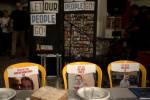Christmas traditions: Santa, gifts, newspapers
Yes, 'tis the uniquely American season for mistletoe and holly, tinsel and toys, Santas and sleighs, carols and crèches, good cheer and anachronistic poetic contractions.
'Twas a time when Christmas in America was a less hectic season. Why, the Puritans even banned its celebration. But the Dutch brought their bearded Sancte Claus or Sinterclaas to New Amersterdam, where the children would find candies and nuts and trifling trinkets in their shoes or stockings. The Germans brought a similar tradition with their Pelze-Nicol.
As the Colonies gained their independence and the people adopted a new Constitution and formed their own customs apart from those of Europe, few newspapers of the day took any notice of the holiday, which was more a churchly matter than one of public interest.
Occasionally, a merchant would advertise in the local newspaper, offering items for the season.
Then clergyman Clement Clarke Moore penned some whimsical doggerel for his children. A family member copied it and gave it to the Troy Sentinel newspaper, which published it on Dec. 23, 1823, under the title "A Visit from St. Nicholas." 'Twas the start of the plump, elfish gentleman clamoring on rooftops with his sleigh and eight tiny reindeer, slipping down chimneys with a sack full of toys, dressed in fur, the stump of a pipe protruding from a beard white as snow as he wordlessly filled stockings.
 The printing of the poem became an annual tradition in a number of newspapers -- under the title "The Night Before Christmas" -- continuing to this very day. It popularized the exchange of gifts on Christmas Day and retailers latched onto the idea and soon filled the newspapers with advertising for their holiday goods and gifts.
The printing of the poem became an annual tradition in a number of newspapers -- under the title "The Night Before Christmas" -- continuing to this very day. It popularized the exchange of gifts on Christmas Day and retailers latched onto the idea and soon filled the newspapers with advertising for their holiday goods and gifts.
The man who put rouge on Santa's cheeks and turned his furry suit to crimson was newspaper editorial cartoonist and illustrator Thomas Nast, who first drafted Moore's character into the Union Army in his Harper's Weekly drawing that depicted Santa in stars and stripes, handing out gifts to soldiers.
He continued to draw Santa for various newspapers and books for years to come.
As the holiday customs took shape it did not take long for some to bemoan how the religious nature of the day was being nudged out by the commercialism.
'Twas Harriet Beecher Stowe among the first, writing in "The First Christmas in New England": "And this holy time, so hallowed and so gracious, was settling down over the great roaring, rattling, seething life-world of New York in the good year 1875. Who does not feel its on-coming in the shops and streets, in the festive air of trade and business, in the thousand garnitures by which every store hangs out triumphal banners and solicits you to buy something for a Christmas gift? For it is the peculiarity of all this array of prints, confectionery, dry goods, and manufactures of all kinds, that their bravery and splendor at Christmas tide is all to seduce you into generosity."
Review-Journal cartoonist and amateur historian of all things illustrated Jim Day reminds that the iconic image of Santa Claus that we see everywhere today was created in 1931 by Haddon Sundblom for Coca-Cola's holiday print ads. The images of the jolly gentleman with Coke bottle in hand appeared through 1964.
And no nostalgic musing on this holiday season and the role of newspapers could omit the editorial response to an 8-year-old's query that appeared in New York's The Sun in 1897.
'Twas Virginia O'Hanlon who asked: "Please tell me the truth; is there a Santa Claus?"
To which editorial writer Francis Church replied: "Yes, VIRGINIA, there is a Santa Claus. He exists as certainly as love and generosity and devotion exist, and you know that they abound and give to your life its highest beauty and joy. Alas! how dreary would be the world if there were no Santa Claus. It would be as dreary as if there were no VIRGINIAS."
This Christmas morn 'twill be a good time to curl up in a cozy chair, watch the children play with their new toys, sip your coffee and read the newspaper ... which, unabashedly, made it all happen.
Whatever happened to Virginia?























